CoraleneNIPPON PORCELAIN VASE JAPANESE US PATENT 912,171 NBR FEB 9 1909
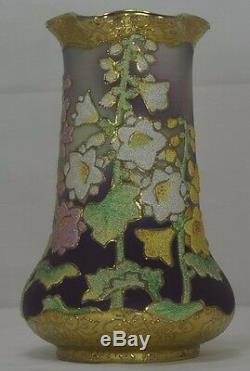

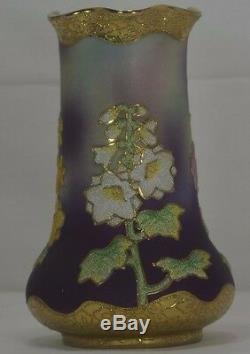
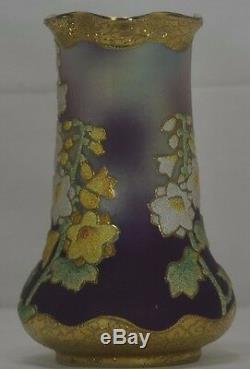
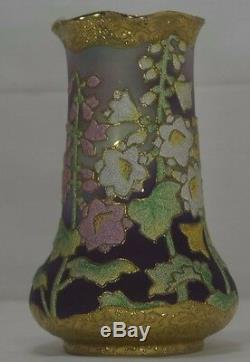

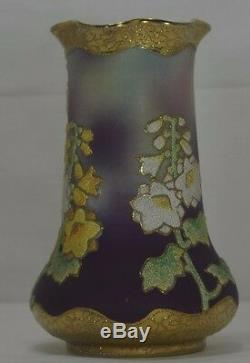
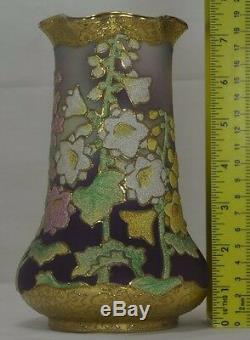

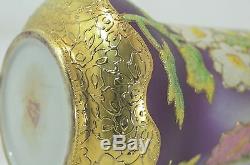

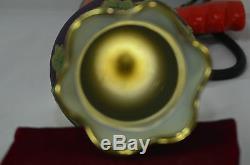

Simply astonishing vintage piece and there no photo's that I have taken that truly show the beauty of this rare and. Fine craftsmanship of this item. Japanese Nippon vase with magnificent Coraleone decoration, which involved applying tiny, clear-glass beads to the surface of the piece to form a. They magnify the colors underneath and, in the right light, actually glow. This Nippon Coralene vase is stands 7 7/8" tall with a 3" base and a 4 5/8 widest point.
The opening of the vase is 3 5/8 wide. Large amount of gold trim at top and bottom all raised with swirls and beads designed. Purples, pinks, greens, yellows, and white pastels. Gold etching surround each flower and stems.
9 1009 stamped on the bottom along with several Asian characters. These were patented in America by Japan, so.
That they can not be copied in America and mass produced by American companies. "Nippon" means that these were made in Japan.In these vases is in their design. The Coralene is what makes these so valuable and sought after. The vase is painted on, and then the clear.
Glass beads are melted onto the painted areas. Condition: There is a hair line fracture on bottom and is not visible looking inside of vase in photo # 12 I shined a light through the bottom to. On purple area about the size of a pin head missing purple stain, look at picture with spot light pointing it out in bottom pictures.
Beautiful piece of History and Craftsmanship that are getting hard to find. Try the new Google Patents, with machine-classified Google Scholar results, and Japanese and South Korean patents. A A Vantine & Co. Referenced by (4), Classifications (1).External Links: USPTO, USPTO Assignment, Espacenet. DESCRIPTION (OCR text may contain errors). INVENTOH fiiczrzllfloc/Z By ATTORNEYS I w.
WITNESSES UNITED STATES PATENT OFFICE. ROUK, Ol YOKOHAMA, JAPAN, ASSIGNOR TO A. A CORPORATION OF NEW'JERSEY. To all whom it may concern. Be it known that I, ALBAN L. ROCK, a citizen of the United States, at present residing in Yokohama, Japan, have invented a new and Improved Pottery Ornamentation, of which the following is a full, clear, and exact description. The object of the invention is to provide a new and improved pottery ornamentation, the ornamentation being arranged to produce a permanent glass bead effect on porcelain vases and other pottery articles, in such a manner that the colorless transparent glass beads are fused in position on the body of the pottery article by a fusing pigment which produces color effect in any predetermined design. The invention consists of novel features and parts and combinations of the same, which will be more fully described hereinafter and then pointed out in the claim.A practical embodiment of the invention is represented in the accompanying drawings, forming a part of this specification, in which similar characters of reference indicate corresponding parts in all the views. Figure l is a side elevation of a vase showing the improvement and produced according to my method; Fig. 2 is an enlarged side elevation of part of the same; and Fig. 3 is a transverse section of the same.
A portion of the surface of the body A of the vase shown in Fig. L, is ornamented by a suitable gold ornamentation B, and the remaining surface portion is covered by a glass bead ornamentation C, which consists of a fusing and carrying medium C and colorless transparent glass beads C fused to the surface of the body A by the said fusing and carrying medium C. The beads C are comparatively small and are preferably spherical in shape, and the fusing and carrying medium C may be in a plain uniform color or in many colors, according to a predetermined design, as indicated at the portions representing the flowers on the vase shown in Fig.
The fusing and carrying medium C consists of porcelain pigments and a fusible matter, either mixed together prior to the application on the body, or applying the said pigments first and then the fusible matter. Sometimes both methods are used on the same article. As a rule, color work on porcelain showing bead decorations, is done in a dull color effect by means of mixing shiroye, balsam copaiba Specification of Letters Patent. Application filed'Aug'ust 19, 1908. With oil of turpentine, and then the outline of the bead design is done by a specially prepared pigment which when fired results in the gold-moriage. The principal components of the fusible matter are 2% grains of silicate of albumen (shiroye) and 192 grains of flux (hakukyoku) to which is added as a carrying medium about 9.6 grains of a dry porcelain pigment or color, the several ingredients belng mixed with a certain percentage of Water and all parts are well ground together. The porcelain color or pigment used with the fusible -matter to form the fusible and carrying medium O must be of such a shade as can be fired satisfactorily at a uniform degree of heat, as otherwise some of the colors will not be fired enough while other shades may be fired too much, and the slightest mistake in the selection of color shades in this respect tends to spoil the article. In practice, the fusing and carrying medium C is applied to the body of the vase in a wet state, and then the colorless transparent glass beads C are placed onto the said wet fusing and carrying medium, which holds the beads in position one alongside the other, as the rear portions of the beads are pressed into the wet medium. The vase or other article thus decorated is then fired in the usual manner, so that the beads are fused with their rear portions onto the porcelain body by the fusing and carrying medium, to permanently fix the beads in place without destroying their brilliant effect, enhanced by the underlying color pigment arranged accordingly to a predetermined design representing flowers and other objects. It is understood that the colors of the fusing and carrying medium. Are refracted through the glass beads, thus giving the vase a very fine appearance in a plush effect. It is understood that the selection of the fusible and carrying medium and the degree of heat used in firing is of importance as the fusible-matter must necessarily fuse at a lower degree than the glass beads C so that only the rear portions of the glass beads which are in contact with the fusible matter melt and fuse with the fusible matter, fused and adhering to the body A of the vase or like article. It is important in the use of the glass bead covering or the predetermined pattern for the different particles to lie closely together and to be distributed thus uniformly in close contact with each other throughout the area of the pattern produced upon the vase or is produced directly upon a pane of glass or the like.By the beaded construction it will be noticed that the surface ornamentation of the vase or other article will be approximately smooth and simulate a plain surface as to touch without affecting the beauty of appearance gained by the spherical form of the beads as shown. Having thus described my invention, I claim as new and desire to secure by Letters Patent. A vase or like pottery article having a body, a fusin and carrying medium disposed on said ody and colored and shaped to conform to a predetermined design, and spherical medium and fused into connection therewith and following the outline of the design produced by the fusing and carrying medium, whereby to form a covering for the medium which will be uniform throughout the extent of the design; and through which the said medium will be refracted, giving to the articlean ornamental appearance in plush effect. In testimony whereof I have signed my name to this specification in the presence of a two subscribing witnesses. Marker and process of making it.
Method of forming a raised metallic design on a vitreous surface. Reflex reflecting article for use as a sign or the like. Plastic coated containers having embedded friction reducing particles. The item is described to the best of my ability and pictures provided to help the purchaser determine the condition of the item(s). I will gladly send additional pictures and answer any questions you have.
We will do our best to correct any mistakes. We do our absolute best to accurately describe our items. The item "CoraleneNIPPON PORCELAIN VASE JAPANESE US PATENT 912,171 NBR FEB 9 1909" is in sale since Wednesday, January 10, 2018. This item is in the category "Antiques\Asian Antiques\Japan\Vases". The seller is "buytheblock" and is located in Ocala, Florida. This item can be shipped to United States, Canada, United Kingdom, Denmark, Romania, Slovakia, Bulgaria, Czech republic, Finland, Hungary, Latvia, Lithuania, Malta, Estonia, Australia, Greece, Portugal, Cyprus, Slovenia, Japan, China, Sweden, South Korea, Indonesia, Taiwan, South africa, Thailand, Belgium, France, Hong Kong, Ireland, Netherlands, Poland, Spain, Italy, Germany, Austria, Bahamas, Israel, Mexico, New Zealand, Singapore, Switzerland, Norway, Saudi arabia, Ukraine, United arab emirates, Qatar, Kuwait, Bahrain, Croatia, Malaysia, Brazil, Chile, Colombia, Costa rica, Panama, Trinidad and tobago, Guatemala, Honduras, Jamaica, Egypt, Peru, Viet nam, Uruguay.- Type: Vases
- Region of Origin: Japan
- Age: Early 1900's
- Primary Material: Porcelain & Pottery
- Maker: Nippon
- Color: Multi

